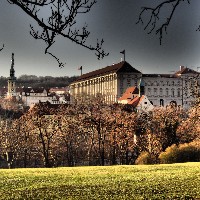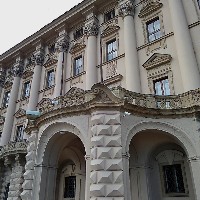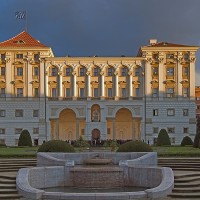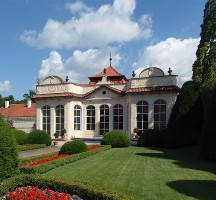Breadcrump- bzw. Brotkrümel-Navigation
Černín Palace
Baroque Černín Palace from 1675 is the seat of the Ministry of Foreign Affairs. The palace is Prague’s longest Baroque building; the front is 150 m long.
- Sehenswürdigkeiten & Architektur
- Palais
- Barock
Kontakte
- Černín Palace
- Loretánské náměstí 5
- Praha 6 – Hradčany
- +420224181111
Objektgeschichte
The palace was built according to a project of arch. Francesco Caratti in 1669 - 1682 for Count Jan Humprecht Černín of Chudenice, the imperial ambassador in Venice. When Caratti died, the construction was managed by Giovanni Battista Maderna, Domenico Egidio Rossi, Giovanni Battista Alliprandi and Giovanni Battista Allio. Stonework was carried out by Giovanni Pozzi, Domenico Semprizi, J. Santini - Aichel; stucco decorations are the work of Francesco Perri, Antonio Travelli and Santin Bussi, paintings were carried out by Lazar Maria Sanguinetti. The building was completed in high-Baroque style in 1717 - 1723 according to projects of František Maximilán Kaňka. In the central tract, there is a monumental staircase topped by a swift and a vault, in which Václav Vavřinec Reiner painted a huge fresco named The Fall of the Titans in 1718. Matyáš Bernard Braun created a group of statues of Mercury, Andronica and Cupid at the foot of the staircase, groups of putti - the light bearers, and decorative vases on the balustrade.
In 1742, the palace was plundered by the French and Bavarian armies. Reconstruction was carried out in 1744 - 1749 by Anselmo Lurago, who designed and built new portals in the main front, connected by a balcony. He cooperated with the sculptor Ignác František Platzer (Hercules in the garden front’s arcade), the painter Siardus Nosecký (repair of Reiner’s fresco), and the plasterer Bernardo Spinetti. The palace was damaged for the second time during Prussian shelling in 1757, with reconstruction carried out by Jan Antonín Quitainer. At the end of the 18th century, the Černín family moved to Vienna and the palace remained abandoned - it gradually served as a hospital, residence for the poor, card-making plant, hops storage place. In 1848 the state bought it and established barracks within the premises, which left a mark in devastated interiors.
In 1928 - 1934, the palace underwent a reconstruction lead by arch. Pavel Janák, who followed the original projects of Francesco Caratti, and sensitively removed the previous reconstructions and additions of the Baroque building.
The palace is the seat of the Czech Ministry of Foreign Affairs; the original inventory has partly been preserved, as well as the office of Jan Masaryk (it is not accessible for public).
Information source: http://www.mzv.cz





